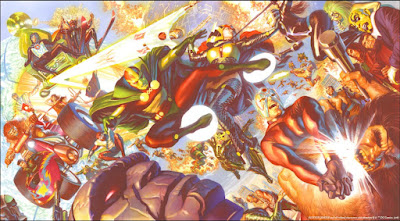It is no secret that clerics have always held a bit of an uneasy place in D&D. They were supposedly inspired by the vampire hunters of Hammer Horror with some further borrowings from Crusader orders. Even if later editions with variable domains, weapons, and powers have ameliorated there implicitly Christian, monotheistic origins, we are still left with them serving pantheons drawn from modern imposed-systemization on characters from later versions of myth, a systemization alien to actually polytheistic religions. But still, it's only a game, we can run with that, right?
Well, we're still left with unanswered questions regarding how the cleric class fits into the structure of religious organizations. Do
all priests have spells? If so, where do they get the experience to go up in level?
Here are some possibilities drawn from real world examples that are potential answers, though of course not the only answers, to these questions. Most of these assume clerics adventure because they are "called" to in some way. Whether this is a legitimate belief on the part of the cleric and society or a mistaken one would depend on the setting.
Lay Brothers
Clerics are not ordained priests but warrior lay brethren, like the sohei of Japan or the military orders of Europe. They would overlap a bit with paladins, but that's real just a matter of whether they were stronger in faith or battle. In this version, priests might or might not have spells, but if they did it would strictly be at the dispensation of their deity.
Prophets/Evangelists
This is more or less the idea I proposed in
this post. Clerics are outside the church hierarchy, though they may or may not have started there. They were chosen by their deity for a special purpose. They may be reformers of a church that has been corrupted or lost it's way, founders of a heretical sect with a new interpretation, or the first in ages to hear the voice of a new god. Priests here may have no magic or may be powerful indeed but erroneous in their theology.
Mystics
Similar to my "
Saints and Madmen" ideas before, mystics are either heretics or at the very least esotericists with a different take on their religion than the mainstream one. The difference between this and the Prophet above is that they have no interest in reforming the church or overturning it, they are either hermits or cult leaders who isolate themselves from the wider world to pursue their revelations. John the Baptist as portrayed in
The Last Temptation of Christ would fit here, as would perhaps the Yamabushi of Japan, or certain Daoist sects/practitioners in China. They might be not at all scholarly (with all spells/powers being "gifts of grace" unavailable to less fanatical priests) or very scholarly with powers/spells coming from intense study or mediation which even more mainstream priests cannot master.
Special Orders
Clerics are members of special orders within the church hierarchy dedicated to recovering the wealth and lost knowledge of dungeons for the the glory of their deity and the betterment of their church. Not all priests have spells. Clerics are priests chosen for their aptitude or particular relationship with the divine or whatever. These orders may be quite influential within the church hierarchy, but their mission thin their ranks and keeps them in the wilderness and away from centers of power--perhaps by divine will or by design of church leaders.


































